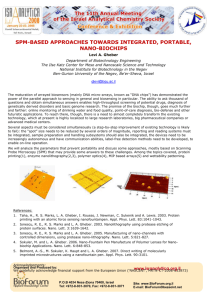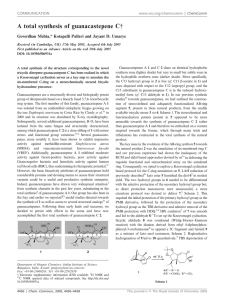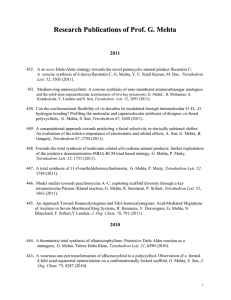Enantioselective total synthesis of a novel polyketide natural product
advertisement
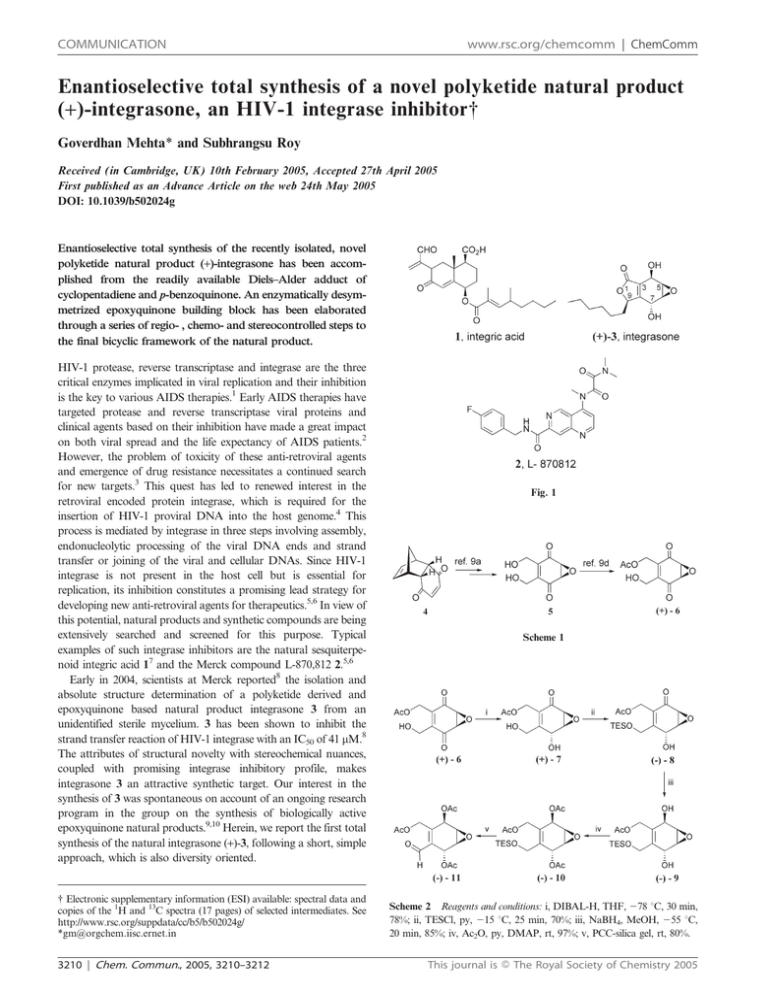
COMMUNICATION
www.rsc.org/chemcomm | ChemComm
Enantioselective total synthesis of a novel polyketide natural product
(+)-integrasone, an HIV-1 integrase inhibitor{
Goverdhan Mehta* and Subhrangsu Roy
Received (in Cambridge, UK) 10th February 2005, Accepted 27th April 2005
First published as an Advance Article on the web 24th May 2005
DOI: 10.1039/b502024g
Enantioselective total synthesis of the recently isolated, novel
polyketide natural product (+)-integrasone has been accomplished from the readily available Diels–Alder adduct of
cyclopentadiene and p-benzoquinone. An enzymatically desymmetrized epoxyquinone building block has been elaborated
through a series of regio- , chemo- and stereocontrolled steps to
the final bicyclic framework of the natural product.
HIV-1 protease, reverse transcriptase and integrase are the three
critical enzymes implicated in viral replication and their inhibition
is the key to various AIDS therapies.1 Early AIDS therapies have
targeted protease and reverse transcriptase viral proteins and
clinical agents based on their inhibition have made a great impact
on both viral spread and the life expectancy of AIDS patients.2
However, the problem of toxicity of these anti-retroviral agents
and emergence of drug resistance necessitates a continued search
for new targets.3 This quest has led to renewed interest in the
retroviral encoded protein integrase, which is required for the
insertion of HIV-1 proviral DNA into the host genome.4 This
process is mediated by integrase in three steps involving assembly,
endonucleolytic processing of the viral DNA ends and strand
transfer or joining of the viral and cellular DNAs. Since HIV-1
integrase is not present in the host cell but is essential for
replication, its inhibition constitutes a promising lead strategy for
developing new anti-retroviral agents for therapeutics.5,6 In view of
this potential, natural products and synthetic compounds are being
extensively searched and screened for this purpose. Typical
examples of such integrase inhibitors are the natural sesquiterpenoid integric acid 17 and the Merck compound L-870,812 2.5,6
Early in 2004, scientists at Merck reported8 the isolation and
absolute structure determination of a polyketide derived and
epoxyquinone based natural product integrasone 3 from an
unidentified sterile mycelium. 3 has been shown to inhibit the
strand transfer reaction of HIV-1 integrase with an IC50 of 41 mM.8
The attributes of structural novelty with stereochemical nuances,
coupled with promising integrase inhibitory profile, makes
integrasone 3 an attractive synthetic target. Our interest in the
synthesis of 3 was spontaneous on account of an ongoing research
program in the group on the synthesis of biologically active
epoxyquinone natural products.9,10 Herein, we report the first total
synthesis of the natural integrasone (+)-3, following a short, simple
approach, which is also diversity oriented.
{ Electronic supplementary information (ESI) available: spectral data and
copies of the 1H and 13C spectra (17 pages) of selected intermediates. See
http://www.rsc.org/suppdata/cc/b5/b502024g/
*gm@orgchem.iisc.ernet.in
3210 | Chem. Commun., 2005, 3210–3212
Fig. 1
Scheme 1
Scheme 2 Reagents and conditions: i, DIBAL-H, THF, 278 uC, 30 min,
78%; ii, TESCl, py, 215 uC, 25 min, 70%; iii, NaBH4, MeOH, 255 uC,
20 min, 85%; iv, Ac2O, py, DMAP, rt, 97%; v, PCC-silica gel, rt, 80%.
This journal is ß The Royal Society of Chemistry 2005
Scheme 3 Reagents and conditions: C6 H13 MgBr, THF, 210 uC, 30 min.
Scheme 4 Reagents and conditions: i, K2CO3, MeOH, 0 uC, 85%; ii, TEMPO, NaOCl, NaClO2, NaH2PO4, 4 h, 50%.
Our synthetic pursuit of integrasone (+)-3 emanated from the
readily available Diels–Alder adduct 4 of cyclopentadiene and
p-benzoquinone, which can be conveniently elaborated to meso-5
in two steps involving epoxidation of the 1,4-enedione moiety
followed by two carbon–carbon bond connectivities through
double hydroxymethylation.9a Further, we have recently demonstrated an efficient protocol for the desymmetrization of 5 through
enzymatic transesterification to furnish enantiomerically pure (+)-6
(.99% ee)9d and this monoacetate served as the key building block
for the synthesis of integrasone 3 (Scheme 1).
The first task en route to 3 was to effect stereoselective carbonyl
group reductions in (+)-6 to generate the requisite hydroxyl
stereochemistry at C4 and C7 present in the natural product.
DIBAL-H reduction of 6 was regio- and stereoselective at C7,
directed by the free primary hydroxyl group and the epoxide
oxygen, to furnish (+)-7 as a single product.9e,11 The primary
hydroxyl group in 7 was selectively TES-protected to give 8 and
further stereoselective sodium borohydride reduction of the C4
carbonyl group from the face opposite to the epoxide ring
furnished the diol 9,11 (Scheme 2). The two hydroxyl groups at C4
and C7 in 9 were readily protected as the diacetate 1011 and direct
PCC oxidation12 led to aldehyde 1111 through TES deprotection
and oxidation of the primary hydroxyl group.
At this stage the cyclohexyl side arm present in the natural
product needed to be installed at C9 with concomitant placement
of the key hydroxyl group required for the c-lactone ring
formation.
Consequently aldehyde 11 was treated with hexylmagnesium
bromide and the reaction to our delight was highly stereoselective
to furnish 1211 and 13 (10:1), although in a modest y40% overall
yield. In addition, the triacetate 14 (42%) was also obtained
through the reduction of aldehyde 11 and acetate migration,
(Scheme 3).13 The stereoselectivity leading to the preferred
formation of the triacetate 12 during the Grignard addition could
This journal is ß The Royal Society of Chemistry 2005
be a consequence of the directing influence of the C7 acetate
group, which subsequently migrates to C9 position.
The stage was now set for the end game to deliver the natural
product. Careful base hydrolysis in 12 delivered the highly polar
tetrol 1511 which was subjected to selective oxidation of the
primary hydroxyl functionality with sodium chlorite catalyzed by
TEMPO and bleach.14 Quite remarkably, this reaction directly
furnished integrasone (+)-3 in 50% isolated yield through the
concomitant cyclization of the proposed carboxylic acid intermediate15 16, (Scheme 4). The identity of our synthetic material
was fully established through the comparison of the 1H and 13C
NMR spectra11 and specific rotation, [a]D +16.6 (c 0.36, MeOH)
with that of the natural product, lit.8 [a]D +16.7 (c 1.5, MeOH).
In summary, we have accomplished a short, simple enantioselective total synthesis of the recently reported integrase inhibitor
integrasone (+)-3 from readily available building blocks. Besides
confirming the absolute configuration of the natural product, the
synthesis is intrinsically diversity oriented and should pave the way
for accessing analogues.
This research was supported by the Chemical Biology Unit
(CBU) of JNCASR, Bangalore. We would like to thank Dr. Sheo
Bux Singh of Merck Research Laboratories for the comparison
spectra of the natural product.
Goverdhan Mehta* and Subhrangsu Roy
Department of Organic Chemistry, Indian Institute of Science,
Bangalore, 560012, India. E-mail: gm@orgchem.iisc.ernet.in;
Fax: +91-80-23600936; Tel: +91-80-22932850
Notes and references
1 H. Fan, R. F. Conner and L. P. Villarreal, Biology of AIDS, (4th
edition), 2000, Jones and Bartlett Publishers, Sudbury MA.
2 D. D. Richman, Science, 1996, 272, 1886.
3 (a) F. Rodriguez-Barrios and F. Gago, Curr. Top. Med. Chem., 2004, 4,
991; (b) S. J. Little, S. Holte, J.-P. Routy, S. E. Daar, M. Markowitz,
Chem. Commun., 2005, 3210–3212 | 3211
4
5
6
7
8
9
C. A. Collier, A. R. Koup, W. J. Mellors, E. Connick, B. Conway,
M. Kilby, L. Wang, M. J. Whitcomb, S. N. Hellman and
D. D. Richman, N. Engl. J. Med., 2002, 347, 385.
R. Craigle, J. Biol. Chem., 2001, 276, 23213.
D. J. Hazuda, P. Felock, M. Witmer, A. Wolfe, K. Stillmock,
J. A. Grobler, A. Espeseth, L. Gabryeliski, W. Schleif, C. Blau and
M. D. Miller, Science, 2000, 287, 616.
D. J. Hazuda, S. D. Young, J. P. Guare, N. J. Anthony, R. P. Gomez,
J. S. Wai, J. P. Vacca, L. Handt, S. L. Motzel, H. J. Klein,
G. Dornadula, R. M. Danovich, M. Witmer, K. A. A. Wilson,
L. Tussey, W. Schleif, L. Gabryeliski, L. Jin, M. D. Miller,
D. R. Casimiro, E. A. Emini and J. W. Shiver, Science, 2004, 305, 528.
(a) S. B. Singh, D. Zink, J. Polishook, D. Valentino, A. Shafiee,
K. Silverman, P. Felock, A. Teran, D. Vilella, D. J. Hazuda and
R. P. Lingham, Tetrahedron Lett., 1999, 40, 8775; (b) S. B. Singh,
P. Felock and D. J. Hazuda, Bioorg. Med. Chem. Lett., 2000, 10, 235.
K. B. Herath, H. Jayasuriya, G. F. Bills, J. D. Polishook,
A. W. Dombrowski, Z. Guan, P. Felock, D. J. Hazuda and
S. B. Singh, J. Nat. Prod., 2004, 67, 872.
(a) G. Mehta and K. Islam, Tetrahedron Lett., 2003, 44, 3569; (b)
G. Mehta and S. S. Ramesh, Tetrahedron Lett., 2004, 45, 1985; (c)
3212 | Chem. Commun., 2005, 3210–3212
10
11
12
13
14
15
G. Mehta and K. Islam, Org. Lett., 2004, 6, 807; G. Mehta and
S. C. Pan, Org. Lett., 2004, 6, 811; (d) G. Mehta and K. Islam,
Tetrahedron Lett., 2004, 45, 3611; (e) G. Mehta and S. Roy, Org. Lett.,
2004, 6, 2389; G. Mehta and S. C. Pan, Org. Lett., 2004, 6, 3985.
For a recent review on epoxyquinol natural product synthesis, see:
J. Marco-Contelles, M. T. Molina and S. Anjum, Chem. Rev., 2004, 104,
2857.
All new compounds were fully characterized on the basis of spectral
data (IR, 1H, 13C NMR, and HRMS). For the spectral data and
copies of spectra of selected compounds, see Supplementary
Information.
A. Rodrı́guez, M. Nomen, B. W. Spur and J. J. Godfroid, Tetrahedron
Lett., 1999, 40, 5161.
Efforts were made to optimize the yield of the required product (2)-12
by varying the temperature and solvent. At lower temperature
(,210 uC) the reaction was sluggish, while at higher temperature
(y0 uC) more of the reduction product 14 was formed.
M. Zhao, J. Li, E. Mano, Z. Song, D. N. Tschaen, E. J. J. Grabowski
and P. J. Rider, J. Org. Chem., 1999, 64, 2564.
An alternate possibility of formation of (+)-3 from 15 via the
intermediacy of a lactol cannot be ruled out.
This journal is ß The Royal Society of Chemistry 2005
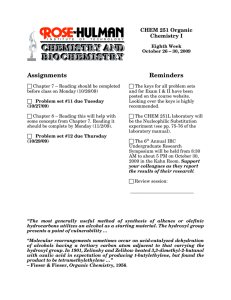
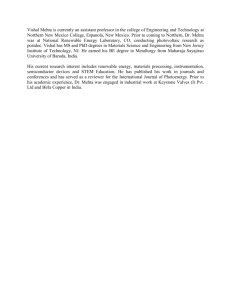

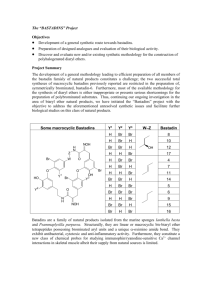

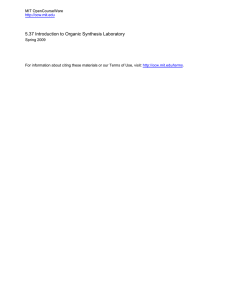
![Anti-HIV1 integrase antibody [IN-2] ab66645 Product datasheet 1 References Overview](http://s2.studylib.net/store/data/012533989_1-324f7b1c61f43ee6787654591d79fc4e-300x300.png)
